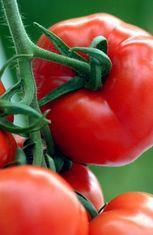

2004 will see several notable changes in the range of tomatoes supplied under the Flandria quality label from Belgium, particularly in the segments Prince, Baron and Princess. For the first time Flandria miniprunellas will also be available.
“The many changes we're seeing this year are due to the introduction of a number of new varieties for which the sector has high hopes,” said Raf De Blaiser, LAVA's Quality Manager. “These varieties were grown in 2003 as a large-scale experiment, closely monitored by both the research centres and the auction quality managers. The results were so convincing that many producers switched part of their production to these varieties. Something else worth highlighting is that these new varieties all scored fairly well to very well in the intensive taste tests.”
Another reason for variety renewal is the new-found confidence evident in the sector. De Blaiser added: “Our tomato producers are starting to look at potentially profitable investments again. They have had extra glasshouses built and are now also investing in new lighting for year round delivery of tomatoes, even in the winter period”.
Balance between vine and loose tomatoes
The proportion of loose tomatoes in the 2004 Flandria range is on the increase, while the proportion of vine tomatoes remains stable. De Blaiser explained: “The production area devoted to loose tomatoes has increased by 5.2 per cent to 254.8 hectares. In comparison, the total area planted with vine tomatoes has only grown by 0.9 per cent. The reason for this is that the ratio of loose to vine in the Flandria tomato range is now balanced, perfectly matching what the market demands and can cope with.”
The loose tomato range
• Prince: this segment will grow by as much as 20 per cent in 2004. “Almost 23ha have been planted with the new variety DRW 7206,” said De Blaiser. “It combines high productivity with a deep red colour. The fruits are slightly heavier than Tradiro tomatoes. Another reason for the growth in the Prince segment is the substantial planted area devoted to Loredana (6ha). This variety scored very well in taste tests and has slightly ribbed fruits.”
• Baron: with a planted area of about 71ha, Marcarena is easily the principal variety in this segment. De Blaiser: “The sector is very enthusiastic about this variety. Not only is its productivity 7-8 per cent higher than that of Quest (until last year the main variety in the Baron segment), the fruits are also very firm. Even after 10 days on the shelf they still feel firm to the touch and that's a real plus for both retailers and consumers. Marcarena also got the highest score in the May taste tests.”
The vine tomato range
• Pittoresk: this segment is still the largest in the vine tomato range and is even up slightly in 2004 (+ 1.5 per cent). Clotilde continues to be the leading variety.
• Elite: this segment is down by 12 per cent, due to the switch to Princess and Prunella.
• Princess: has seen a remarkable 25 per cent increase. De Blaiser: “That’s mainly due to the fact that an area of almost 6ha has been planted with the Brilliant variety. This highly productive vine tomato has bright red fruits and is very resistant to cracking. What's more, the fresh green stalks retain their colour even after storage, something that really appeals to consumers. This year we will also be conducting large-scale experiments with variety DRW 7247, which has a very promising flavour.”
• Ministar: an extra half hectare was planted with these cocktail tomatoes this year. Raf De Blaiser: “Ministar is still a worthwhile, albeit limited niche product.”
• Prunella: following considerable growth in 2003, the production area devoted to these plum tomatoes has once again been increased by 13.5 per cent.
• Miniprunella: a new addition to the Flandria family, offering attractive trusses of mini-plum tomatoes. The total area planted is about 4,000sqm. De Blaiser: “The product already existed, but from now on we can offer it with all the usual guarantees of the Flandria quality mark. It is also available on demand in small packs: one truss or 500g per pack.”
2003 was an exceptional year for Flandria tomatoes, which were less affected by the prolonged period of hot, dry weather than the southern production areas. The result was that vine tomatoes enjoyed a 16. per cent increase in supply and 22 per cent more sales, while the corresponding figures for loose tomatoes were 3.3 per cent and 11.6 per cent. “Based on what we know at the moment, we expect 2004 to be a normal year in terms of both production and retail,” said De Blaiser. “The sector is also looking to see what the peak price level of the first Flandria lighted tomatoes will be and is keeping an eye on the pioneers of this product. During the period from mid-January to mid-February prices were fairly high. Once this is confirmed, it will encourage other producers to follow the example of the innovators and invest in new lighting themselves. This may lead to a significant growth in supply next winter.”






No comments yet